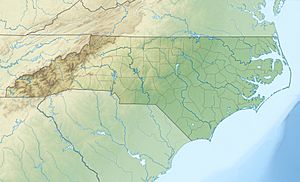Smith Branch (Reedy Fork tributary) facts for kids
Quick facts for kids Smith Branch |
|
|---|---|
|
Location of Smith Branch mouth
|
|
| Other name(s) | Tributary to Reedy Fork |
| Country | United States |
| State | North Carolina |
| County | Guilford |
| Physical characteristics | |
| Main source | divide between Smith Branch and Benaja Creek about 0.25 miles southeast of Monticello, North Carolina 820 ft (250 m) 36°12′54″N 079°39′51″W / 36.21500°N 79.66417°W |
| River mouth | Reedy Fork about 2 miles south of Monticello, North Carolina 662 ft (202 m) 36°10′55″N 079°40′22″W / 36.18194°N 79.67278°W |
| Length | 2.02 mi (3.25 km) |
| Basin features | |
| Progression | generally south |
| River system | Haw River |
| Basin size | 2.75 square miles (7.1 km2) |
| Tributaries |
|
| Bridges | Turner Smith Road |
Smith Branch is a small stream, about 2.02 mi (3.25 km) long. It flows into a larger stream called Reedy Fork. This stream is located in Guilford County, North Carolina. A "tributary" is a smaller stream or river that flows into a larger one.
Contents
Where Does Smith Branch Flow?
Smith Branch starts its journey in Guilford County. It begins near a place called Monticello, North Carolina.
Starting Point
The stream begins where the land divides between Smith Branch and Benaja Creek. This spot is about 0.25 miles southeast of Monticello.
Journey to Reedy Fork
From its start, Smith Branch flows mainly towards the south. It travels for about 2 miles. Finally, it joins Reedy Fork. This meeting point is about 2 miles south of Monticello.
What is the Smith Branch Watershed Like?
A watershed is an area of land where all the water drains into a specific stream or river. The Smith Branch watershed is the area that collects water for this stream.
Size and Environment
The Smith Branch watershed covers an area of 2.75 square miles (7.1 km2). This area gets about 46.0 inches of rain each year. A good portion of the land, about 42%, is covered by forests. This helps keep the water clean and healthy for the stream.



